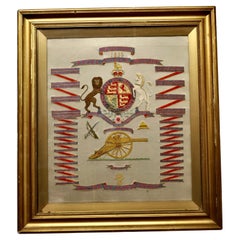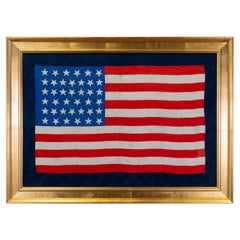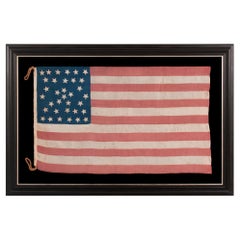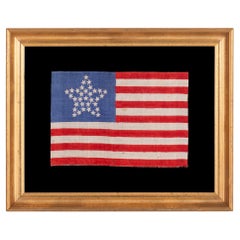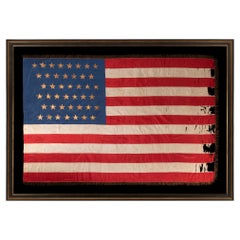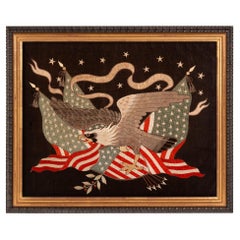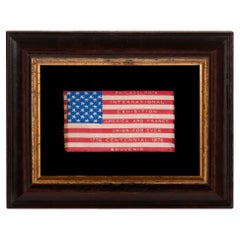Silk Political and Patriotic Memorabilia
9
to
8
1
9
9
9
1
1
9
12
2
10
2
2
4
1
13,320
77
43
19
17
7
7
1
Period: 19th Century
Material: Silk
69th Battery Royal Field Artillery Framed Commemorative Embroidery
Located in Chillerton, Isle of Wight
69th Battery Royal Field Artillery Framed Commemorative Embroidery
A stunning piece, in fine detail applied and embroidered tapestry, showing the counties and campaigns from 1855 ...
Category
19th Century Folk Art Antique Silk Political and Patriotic Memorabilia
Materials
Silk
31-Star Printed American Flag, Celebrating California Statehood, Circa 1850
Located in Colorado Springs, CO
This is a rare 31-star medallion printed American flag, celebrating the addition of California to the Union. The flag is printed on silk and has a spectacular “Great Star” canton pat...
Category
1850s American Antique Silk Political and Patriotic Memorabilia
Materials
Silk
1889 North Dakota 39 Star United States of America Statehood Flag
Located in Coeur d'Alene, ID
39 star silk statehood flag. 23 1/2" x 15". Was the unofficial North Dakota Flag. As South Dakota was also admitted as the 40th state on the same day this...
Category
1880s American Antique Silk Political and Patriotic Memorabilia
Materials
Silk
34 Star Antique American Flag with Hourglass Medallion Stars, ca 1861-1863
Located in York County, PA
EXTRAORDINARY 34 STAR ANTIQUE AMERICAN FLAG WITH AN ACCORDION OR HOURGLASS MEDALLION CONFIGURATION THAT SURROUNDS A PENTAGON OF STARS IN THE CENTER; MADE OF FINE SILK AND ENTIRELY HAND-SEWN; MADE DURING THE OPENING YEARS OF THE CIVIL WAR (1861-63), IN A TINY SIZE AMONG ITS COUNTERPARTS OF THE PERIOD; REFLECTS THE ADDITION OF KANSAS AS THE 34TH STATE
34 star flag of the Civil War period with an array of rare, beautiful, and otherwise desirable features. Extremely small among flags of this period with pieced and sewn construction, the flag displays a star pattern that is not only highly unusual, but unique to this particular example. This consists of a single star in the very center, surrounded by a pentagon of stars, flanked by angular bracket of three stars to either side. Above and below are rows of 5 stars, followed by rows of 6 that line the top and bottom of the canton. The resulting configuration is what I have termed an “accordion medallion,” though “hourglass medallion” or “standing bow tie” would be perfectly acceptable.
When rotated 90 degrees, to view the harder-to-identify, bow tie formation, students of early star patterns may note the visual similarity between this and what I call “Starburst” or “Crosshatch” medallions. The pattern, however, conspicuously lacks the crosses of St. Andrew (a saltire) and St. George (roman cross), that would allow it to be more accurately categorized as such.
Entirely hand-sewn, the canton and stripes of the flag are made of fine silk. The hemming of this was accomplished with great skill. The top and bottom edges are selvedge. These are so similar in nature as to have come from the same maker. There is a white, silk binding along the hoist, in the form of an open sleeve, through which a length of braided hemp rope was passed, expertly looped and re-braided into itself at the top and bottom for strength.
The stars are made of white, polished cotton. These were stitched to both sides (double-appliqued). Note how the edges of the fabric were not turned under, providing evidence of the fact that the maker was not especially skilled in appliqueing. This was common, as applique work was far more difficult than producing French seams.
In the 19th century, most flags with pieced and sewn construction were 8 feet long and larger. A six-footer was considered small. Even military battle flags, carried on foot, measured 6’ x 6.5’, which translates into approximately 7’ x 7.5’ after framing, about the size of an average quilt and larger than can comfortably fit on a wall in a house with 8-foot ceilings and average width baseboard. Flags smaller than this were produced both commercially and at home, but the smaller they are, the more unusual they are. At just 26.5 x 46.5 inches, this flag is extremely small for a Civil war period flag with sewn construction.
Silk was both beautiful and lightweight, which made it elegant for military unit colors and preferable for flags meant to be carried on foot. Most outdoor use flags...
Category
1860s American Antique Silk Political and Patriotic Memorabilia
Materials
Silk
33 Star Flag with Stars in a "Great Star" Pattern, Oregon State, ca 1859-1861
Located in York County, PA
33 STARS IN A "GREAT STAR" PATTER ON A BRILLIANT, ROYAL BLUE CANTON, A RARE AND EXTRAORDINARY EXAMPLE, PRE-CIVIL WAR THROUGH THE WAR'S OPENING YEAR, 1859-1861, OREGON STATEHOOD
33 s...
Category
Mid-19th Century American Antique Silk Political and Patriotic Memorabilia
Materials
Silk
43 Star Antique Silk American Flag, Idaho Statehood, ca 1890
Located in York County, PA
43 GILT-PAINTED STARS ON A SILK, ANTIQUE AMERICAN FLAG WITH BULLION FRINGE; REFLECTS THE ADDITION OF IDAHO AS THE 43RD STATE ON JULY 3RD, 1890, ONE OF THE RAREST STAR COUNTS AMONG SURVIVING AMERICAN FLAGS OF THE 19TH CENTURY
Numerous flags appeared with unofficial star counts in early America, some of them produced by flag-makers in large quantity in anticipation of the addition of more states. Interestingly enough, other flags were officially adopted by the United States Congress, but for all practical purposes were never produced. Among these is the 43 star flag...
Category
1890s American Antique Silk Political and Patriotic Memorabilia
Materials
Silk
38 Star Antique American Flag, Colorado Statehood, ca 1876-1889
Located in York County, PA
38 star antique American parade flag with scattered star orientation, made of silk, with generous scale and vivid colors, Colorado Statehood, 1876-1889
38 star American national p...
Category
Late 19th Century American Antique Silk Political and Patriotic Memorabilia
Materials
Silk
Elaborate Sailor Souvenir of Washington Crossing the Delaware, ca 1885-1912
Located in York County, PA
Elaborate sailor’s souvenir embroidery from the orient with a beautiful hand-painted image of Washington crossing the Delaware, surrounded by a large eagle, federal shield, crossed flags, a cannon, cannonballs, and anchor, circa 1885-1910:
Between roughly 1880 and 1915, American sailors visiting the orient could obtain beautiful needlework embroideries on shore, with patriotic American themes. These extraordinary works of art were acquired as mementos of a long voyage, often with the hope that they might be presented as gifts for loved ones and friends.
Using silk floss, elaborately embellished with both silver and gold metallic bullion thread...
Category
Late 19th Century Asian Antique Silk Political and Patriotic Memorabilia
Materials
Silk
Patriotic Silk Kerchief w/ 34 Star Flags & an Image of Washington, Civil War Era
Located in York County, PA
PATRIOTIC SILK KERCHIEF OF THE CIVIL WAR PERIOD, WITH AN ENGRAVED IMAGE OF GEORGE WASHINGTON, CROSSED 34 STAR FLAGS, AN EAGLE, AND "UNION FOREVER" SLOGAN:
Patriotic kerchiefs that date prior to the 1876 Centennial of American Independence are rare among surviving 19th century textiles. Printed on silk and made during the opening years of the Civil War, this example consists of a white ground with red and blue borders. Inside is a prominent, copper engraved, device that consists of a large image of George Washington, crowned by a spread winged eagle that grasps a billowing streamer in its beak and talons. The ribbon boasts the Federal sentiment "Union Forever." The likeness of Washington is derived from Gilbert Stuart's Athenaeum portrait. Below this is a facsimile of Washington's signature, cradled by crossed American flags, each with 34 stars arranged in circular medallions.
Although political textile historian Herbert Ridgway Collins associated this kerchief with the centennial of American independence,* there is overwhelming evidence that it was produced earlier. The large scale is much more indicative of kerchiefs produced in the 1860's and prior. Made of silk, the binding is hand-stitched, which is also common of those produced before 1876. When these facts are added to the pro-Union Civil War slogan and flags in the 34 star count, the combination of all these factors points firmly to Civil War period manufacture. Kansas was admitted into the Union as the 34th state on January 29th, 1861, about two-and-a-half months before the Confederate assault on Fort Sumter that marked the beginning of the Civil War. The 34th star was officially added on July 4th of that year and the star count remained official until July 4th, 1863.
Further evidence can be found in an example of this kerchief that resides in the collection of the Adams County, Pennsylvania Historical Society, with firm provenance to a woman by the name of Emma Yount. The story goes like this: “With the Battle of Gettysburg looming and the countryside in turmoil, the Union cavalry rode into Gettysburg on the afternoon of June 30, 1863. The troopers dismounted and lounged in the town while awaiting further orders. During that time, the seven year old daughter of innkeeper Israel Yount, Emma, was playing outside their home when a cavalryman asked her to come and visit with him while he was resting. The cavalryman told her that he missed his young daughter at home and asked if little Emma would hug and kiss him on the cheek to remind him of his daughter, who he felt he might not ever see again. Emma asked her mother if she could do as the cavalryman suggested, and her mother considered the circumstances and allowed Emma to do so. Before leaving, the cavalryman gave young Emma a silk handkerchief he was carrying that featured George Washington's image and patriotic border and flags. Emma kept that handkerchief until her death in 1946 and it was then donated to the Adams County Historical Society.”
The trio of brass rings, hand-sewn along the top edge, would have been added by a former owner so that it could be hung vertically. The textile itself is both beautiful in design and rare. Outside of an example pictured by Collins in his book “Threads of History” (Smithsonian Press, 1979), and the copy in the Adams County Historical Society, only three others like it are known to have surfaced, including this example. This condition is excellent for the period and it survives as an exceptional relic of the War Between the States.
It is of interest to note that kerchief bears marked similarities to another, especially rare, pro-Union variety, that was produced in London for the American market. Notably larger in scale, but very much alike in terms of the fabric, the printing, the shades of red and blue, the verbiage, and the general overall graphic feel, it was produced by Foster & Porter, a known, English maker of printed kerchiefs. Instead of featuring George Washington, the imagery centers on a large cannon...
Category
1860s American Antique Silk Political and Patriotic Memorabilia
Materials
Silk
Related Items
Early 20th c. Monumental Belgian Flag c.1940-1950-FREE SHIPPING
Located in San Francisco, CA
ABOUT
An original monumental Belgian flag.
CREATOR Unknown.
DATE OF MANUFACTURE c.1940-1950.
MATERIALS AND TECHNIQUES Wool, Metal.
CONDI...
Category
Early 20th Century Industrial Silk Political and Patriotic Memorabilia
Materials
Brass
Ann Hand American Eagle Silk Scarf
Located in Colorado Springs, CO
This is a coveted, patriotic silk scarf, issued by American designer Ann Hand. The silk scarf was issued in a deep navy and gold colorway. At center is an art...
Category
21st Century and Contemporary American Silk Political and Patriotic Memorabilia
Materials
Silk
Vintage Italian Flag c.1940 (FREE SHIPPING)
Located in San Francisco, CA
ABOUT
An original Italian flag with brass grommets to hang it.
CREATOR American Flag and Banner Company, San Francisco.
DATE OF MANUFACTURE c.19...
Category
Early 20th Century Industrial Silk Political and Patriotic Memorabilia
Materials
Brass
Large Framed American Flag Folk Art Quilt
Located in Santa Monica, CA
Nicely faded American flag quilt. Excellent hand stitched dancing Folk Art stars. Skilled quilting, a nice graphic large-scale wall hanging. White ...
Category
Early 20th Century North American Folk Art Silk Political and Patriotic Memorabilia
Materials
Cotton
Monumental "Valley Forge" American Flag with 48 Stars, c.1940-1950 (FREE SHIP)
Located in San Francisco, CA
About
This is an original monumental American flag made by Valley Forge Co. with 48 stars and stripes and brass grommets.
Creator Valley Forge Co.
Date of manufacture c.1940-1950.
...
Category
Early 20th Century Industrial Silk Political and Patriotic Memorabilia
Materials
Brass
H 114 in W 60 in D 0.125 in
46-Star American Flag, Antique Printed on Silk, Early 20th Century
Located in Colorado Springs, CO
This is an original 46-star American parade flag, printed on silk. Each star represents a state in the Union at the time. The official flag design would update every July 4th, to inc...
Category
Early 1900s American Antique Silk Political and Patriotic Memorabilia
Materials
Silk
English Painted Wood Dummy Board Depicting a Royal Navy Lieutenant
Located in Southampton, NY
English painted wood dummy board depicting a royal navy lieutenant.
Inscribed 'Made in England' on the reverse.
Measures: 41" high x 21" wide x 9" deep
...
Category
Late 19th Century English Antique Silk Political and Patriotic Memorabilia
Materials
Wood
Early Folk Art American Two Sided Framed Military Drawing with Map
Located in Savannah, GA
This unusual set of drawings in a double sided frame came out of an old New England Estate in a Beacon Hill, Boston home. From what we have gathered, they are hand-colored drawings o...
Category
Late 18th Century American Folk Art Antique Silk Political and Patriotic Memorabilia
Materials
Glass, Wood, Paper
Napoleonic Folk Art Calligraphy Drawing
Located in Greenwich, CT
Unique pen and ink Folk Art drawing with calligraphy boarder depicting Napoleon triumphant in Russia (a French fantasy) with a French flag flying over a Russian palace surrounded by ...
Category
19th Century French Folk Art Antique Silk Political and Patriotic Memorabilia
Materials
Pen, Paper, Giltwood
34-Star Civil War American Flag, Antique Great Star Pattern, circa 1861
Located in Colorado Springs, CO
The stars of this extremely rare, Civil War-era flag are arranged in what is sometimes called the "Great Flower" pattern, a large star made out of smaller stars -- named as such beca...
Category
1860s American Antique Silk Political and Patriotic Memorabilia
Materials
Linen
Large Vintage Wool American Flag with 48 Stars c.1940-1950-FREE SHIPPING
Located in San Francisco, CA
ABOUT
A large wool American flag made with 48 hand sewn stars and stripes. It is in good condition and has brass grommets to hang.
CREATOR Unknown.
DATE OF MANUFACTURE c.19...
Category
Early 20th Century Industrial Silk Political and Patriotic Memorabilia
Materials
Brass
H 117 in W 57.5 in D 0.125 in
Early 20th C. Monumental American Flag with 48 Stars, c.1940-1950
Located in San Francisco, CA
About
This is an original monumental American flag made with 48 hand sewn stars and stripes. It is in good condition and has brass grommets to hang.
Creator unknown.
Date of m...
Category
Early 20th Century Industrial Silk Political and Patriotic Memorabilia
Materials
Brass
Previously Available Items
Sailors Souvenir Embroidery with 13 Stars Crossed Flags and Eagle circa1885-1910
Located in York County, PA
Exceptional sailor’s souvenir embroidery from the orient, with 13 stars, crossed flags, and a federal eagle, perched for flight, on a patriotic shield; significantly larger and more ...
Category
Late 19th Century Asian Antique Silk Political and Patriotic Memorabilia
Materials
Silk
H 29.5 in W 35.75 in D 2.5 in
36 Star Flag Made of Woven Silk For the 1876 Centennial Expo
Located in York County, PA
FRENCH-DESIGNED AMERICAN FLAG, WOVEN SILK WITH TEXT ON BOTH SIDES, PRODUCED FOR THE 100TH ANNIVERSARY OF AMERICAN INDEPENDENCE; LIKELY MADE IN PHILADELPHIA AT THE 1876 CENTENNIAL INTERNATIONAL EXPOSITION
American national flag, made of silk, designed for the 1876 Centennial International Exposition in Philadelphia. This major World’s Fair event, held in Fairmont Park, lasted from May through November of that year, and served as the nucleus of the celebration of our nation’s 100th anniversary of independence.
The flag is woven in the manner of a Stevensgraph (a woven pictorial panel), a process new to the textile industry and no-doubt chosen to be shown off in the many displays of technological advancement that were the primary theme of the fair. The flag has 36 stars, which does not relate to its period of use, probably due to lack of French knowledge concerning the proper number of stars at the time, which was officially 37, though most flags-makers in America were producing examples with 38 or 39 stars.*
Woven onto the red stripes on one side of the flag is the following text: “Philadelphia International Exhibition; America and France; Union For Ever; Souvenir.” Woven into the white stripes on the reverse side is the following: “Philadelphia International Exhibition; Union For Ever; 1776 Centennial 1876; Memento.”
Though the name of the maker is not known, based upon my knowledge of other small woven textiles of this nature, produced and sold at the exposition, I think it very likely that the flag was actually made there, on site, as part of the French exhibit. One of the most significant reasons behind World’s Fair events was to showcase new technology. The ability to utilize modified versions of jacquard weave looms to produce textiles of this nature was a marvel of the time. Most of the pioneers in this field wove bookmarks, cloth postcards, and small, frameable, souvenir textiles. This is the only known variety of parade flag that I know of with this manner of construction. I also know of no other Stevensgraph-like textile that displays images or lettering on both sides of a single length of fabric.
These flags originally came on an unusually nice staff, varnished red, capped with a tiny brass finial. This was of very high quality when compared to almost all other parade flags of any period, most of which are affixed to a simple, unfinished wooden dowel. For some reason, the staffs of these woven silk flags are almost always absent.
* Colorado became the 38th state on August 1st, 1876. This was the year of our nation’s 100-year anniversary of independence. Per the Third Flag Act of 1818, stars were not officially added until the 4th of July following a state's addition. For this reason, 37 was the official star count for the American flag in 1876. Flag-making was a competitive venture, however, and almost no one followed the official guidelines, which the average American probably had no knowledge of anyway. Few flag-makers would have continued to produce 37 star flags, when their competitors were making 38’s to include Colorado. It is for this reason that flags with 38 and 13 stars (to represent the original 13 colonies...
Category
Late 19th Century American Antique Silk Political and Patriotic Memorabilia
Materials
Silk
38 Star American Parade Flag, Colorado Statehood, 1876-89, Battle Flag Style
Located in York County, PA
38 Star antique American parade flag in a square, battle flag style, printed on silk, with beautiful cornflower blue and scarlet red coloration; possibly sold as a kerchief / bandanna; unique among known examples, probably made for the 1888 campaign of Benjamin Harrison; reflects colorado statehood, 1876-1889:
This unusual, square format, printed silk flag is of a type that could be tacked to a staff and waved as a traditional parade flag. Alternatively, it could be gathered and waved from the hand, as a kerchief or bandanna, or worn decoratively as such. At this time in America, flag ethics had not yet taken form, and had only recently begun to be considered.
The count of 38 stars reflects the addition of Colorado as the 38th state on August 1st, 1876. This was the year of our nation’s 100-year anniversary of independence. Per the Third Flag Act of 1818, stars were not officially added until the 4th of July following a state's addition. For this reason, 37 remained the official star count for the American flag in 1876. It was almost universally abandoned, however, as flag-making was a competitive venture, and few flag-makers wished to continue to produce 37 star flags, when their competitors were making 38’s. In fact, some flag-makers would have been adding a star for the 38th state even before it entered the Union, in the early part of 1876, or even prior. In fact, many makers of parade flags were actually producing 39 star flags, in hopeful anticipation of the addition of two more Western Territories instead of one. But the 39th state would not join the Union for another 13 years, when the Dakota Territory entered as two states (numbers 39 and 40) on the same day, on November 2nd, 1889.
A large series of patriotic textiles, such as this, were produced for the successful presidential campaign of Benjamin Harrison in 1888. Most bore the Republican Party slogan of “Protection to American Industries,” or text that conveyed a similar message. At least three different styles, including this one, were both square in shape and bore graphics that were entirely a flag, with no printed text to identify it as anything but that, and with no sort of political advertising.
The profile of this particular flag mimicked that of military battle...
Category
Late 19th Century American Antique Silk Political and Patriotic Memorabilia
Materials
Silk
H 25.25 in W 26.5 in D 2.5 in
American 39 Star Flag, circa 1889
Located in Nantucket, MA
Antique American 39 Star Flag, circa 1889, a period silk made in the "Dancing Star" pattern, where the stars are oriented at an alternating upright and slanted angle (prior to being standardized by Congress). The 39 star flag was never an official American flag sanctioned by Congress, but was made by states to celebrate the two Dakotas admission into the Union in 1889.
The flag is in very good condition, with only a few very small stains, just sufficient to call attention to the age of this flag. Conservation mounted on fabric backing in a tiger maple frame...
Category
1880s American Federal Antique Silk Political and Patriotic Memorabilia
Materials
Silk
13-Star American Flag Silk Banner, circa 1876-1900
Located in Colorado Springs, CO
Presented is a large 13-star American flag banner, in a striking vertical format. The all-silk constructed banner features a rich blue canton with 13 white stars. The silk stars are ...
Category
Late 19th Century American Antique Silk Political and Patriotic Memorabilia
Materials
Silk
39-Star Patriotic Silk Flag, circa 1876-1888
Located in Colorado Springs, CO
This is a 39-star unofficial American flag, printed on silk. The flag dates between 1877 and 1889, showcasing a whimsical star pattern in the canton. The flag's canton boasts a 6/7/7/6/7/6 row pattern of white stars printed on a dark blue ground. Thirteen red and white stripes, to represent the 13 original states in the Union, complete the design.
An official flag with only 39 stars was never approved by Congress. Flagmakers often gambled on how many states would be admitted each year and would produce flags with the number of stars they predicted would be approved that session. These flagmakers assumed the Dakota Territory would be the only new state admitted that year and printed a flag with just one more star than the last. Unfortunately for the company, not only was the territory split into North and South Dakota, but three other states were also added to the new design by the time Congress voted on July 4, 1890. As a result, this 39-star flag is considered “unofficial,” giving the patriotic piece an interesting and unique history.
CONDITION:
Very good condition. Silk flag...
Category
1880s American Antique Silk Political and Patriotic Memorabilia
Materials
Silk
Large Scale, Jacquard Silk Ribbon Made to Mourn the Death of Lincoln ca 1866
Located in York County, PA
EXTRAORDINARY, JUMBO SCALE, JAQUARD-WOVEN, SILK RIBBON, MADE TO MOURN THE DEATH OF ABRAHAM LINCOLN, SIGNED & DATED BY THE MAKER, JORDAN TCHAPP, OF BASEL, SWITZERLAND, 1866:
Exceptional portrait of Abraham Lincoln. on woven, silk ribbon, made in the fashion of a Stevensgraph, signed & dated by Jordan Tchapp of Besel, Switzerland, 1866. Made for the American market, to mourn the death of America’s beloved, 16th president, Lincoln’s image is set within an oval window, crowned with a federal eagle, holding an olive branch in a gesture of peace. Beneath its wings, to each side, is an array of arrows, with shafts in the likeness of lightning bolts. The bird is perched on a billowing streamer that decorates the crest of a fanciful frame, with text that reads “With Charity to all, with malice for none.” [A slight and likely unintentional paraphrase of words taken from Lincoln’s second inaugural address: “With malice toward none, with charity for all.”]
To the left and right of America’s martyred commander-in-chief are 22 stars. If Tchapp designed the work in April of 1865, he may have been referencing the official number of stars on the flag, 35, less the 13 Confederate States. Likely, however, this count is also unintentional. The frame rests in the apex of crossed American flags with star counts of 13 and 15, respectively. These could be copied from an engraving of some sort, as could the remainder of the image. Lady...
Category
1860s Swiss Antique Silk Political and Patriotic Memorabilia
Materials
Silk
Flag Wavers 2-in-1 Celebration, 25-Star and 44-Star Flags Framed Together
Located in Colorado Springs, CO
Presented is a unique celebration of early American parade flag wavers. This item includes two antique American parade flag wavers framed together, a 25-star American flag...
Category
19th Century American Antique Silk Political and Patriotic Memorabilia
Materials
Cotton, Silk
H 11 in W 10.25 in D 1.38 in
Elaborate Sailor Souvenir Embroidery, ca 1896-1907
Located in York County, PA
Elaborate sailor’s souvenir embroidery from the orient with a large Federal eagle, crossed flags, cannon and anchor, ca 1896-1907
Between roughly 1885 and 1915, American sailors visiting the orient could obtain beautiful needlework embroideries on shore, with patriotic American themes. These extraordinary works of art were acquired as mementos of a long voyage, often with the hope that they might be presented as gifts for loved ones and friends.
Using silk floss, elaborately embellished with both silver and gold metallic bullion thread, and combining various types of embroidery work and stitchery, artists working the piers in port towns would create these elaborate pictures, customizing them to the buyer's content. Executed on silk, like this example, or sometimes on velvet, the most common devices included eagles, flags, and shields, often with various maritime elements.
This particular example features a spread-winged, war-like eagle, posed here upon clusters of arrows emerging from the apex of a Federal shield, flanked on either side by trios of American national flags. Laurel leaves spring from the top of the shield, while a cannon barrel and an anchor extend from the base, with a stack of cannon balls to the left and a billowing streamer below. The familiar "E Pluribus Unum" motto appears on the streamer, separated by a single star, interestingly symbolic of the Latin phrase, which means "out of many, one."
It is of interest to note that the count of 45 stars on each flag in the foreground is correct for the period, as well as the count of 13 stars and 13 pales (vertical stripes) on the shield. The attention to detail is relatively amazing, especially given the point of origin. The colors of the pales are reversed, but few are aware of their appropriate positioning on a shield. It was not uncommon for American-made patriotic objects to lack such detail.
Utah became the 45th state in 1896. It had been attempting to gain statehood for many years, but remained a territory, primarily due to the fact that the Mormon Church and Utah authorities continued to be openly tolerant of polygamy. In 1890, Mormon Church President Wilford Woodruff published a manifesto that denounced the contract of “any marriages forbidden by the law of the land”. This gave way to Utah’s 1896 acceptance. The 45 star flag was generally used from that year until 1907, when Oklahoma joined the Union. Due to the Spanish-American War (1898) and Roosevelt’s famous world tour of the “White Fleet” (1907-1909), this was an extremely patriotic period.
When examining the level of craftsmanship, note the glass eye employed in the eagle and the tassels, carefully knotted from metallic bullion thread. Also note the treatment of the raised feathers on the legs, the scales on the talons, and the spiraling chain...
Category
1890s Asian Antique Silk Political and Patriotic Memorabilia
Materials
Silk
34 Stars in a "Great Star" Pattern, Kansas Statehood, ca 1861-63
Located in York County, PA
34 Stars in a "GREAT STAR" Pattern on a Brilliant, Royal Blue Canton, Opening Two Years of the Civil War, 1861-63, Kansas Statehood:
34 star parade flag, printed on silk. The star...
Category
Late 19th Century American Antique Silk Political and Patriotic Memorabilia
Materials
Silk
Stevensgraph Bookmark with Lincoln, Made in New Jersey by Phoenix Mfg
Located in York County, PA
Stevensgraph bookmark with an image of Abraham Lincoln, made in new jersey by phoenix manufacturing co., either for the 1876 centennial international exhibition in Philadelphia, or t...
Category
Late 19th Century American Antique Silk Political and Patriotic Memorabilia
Materials
Silk
38-Star American Parade Flag, Printed on Silk, Commemorating Colorado Statehood
Located in Colorado Springs, CO
This is an exceptional 38-star printed silk American flag. The flag dates to 1876-1890, when Colorado joined the Union as the 38th state. A wonderfu...
Category
Late 19th Century American Antique Silk Political and Patriotic Memorabilia
Materials
Silk
H 17 in W 24 in D 1 in
Recently Viewed
View AllMore Ways To Browse
Lafayette Glass
Embroidered Flag
Sea Captains 19th
Mexican Applique
Vintage American Flag Black And White
American Flags And Americana
Vintage Stars And Stripes Flag
1890s Men
Large Yard Art
1877 Flag
Boat Machine
Rope Machine
34star Flag
34 Star Flag
American Flag With 48 Stars
Antique Black Americana Black Americana
Teddy Roosevelt
Antique Black Americana
